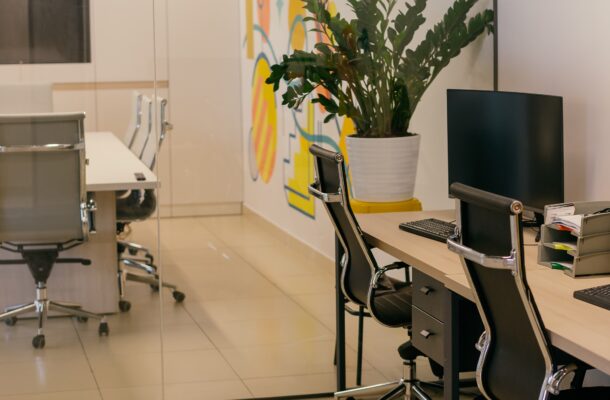Renovating Your Office Space

The workplace environment has evolved significantly over the years, recognizing the profound impact it has on employee productivity, morale, and overall well-being. Well-designed office space is not just a utilitarian necessity; it’s an embodiment of the company’s ethos and a potent tool for nurturing creativity, collaboration, and efficiency. Renovating the office is a strategic step, a declaration that the company is attuned to contemporary trends, values employee satisfaction, and is willing to adapt to a rapidly changing world.
Open Workspace Layout
In recent times, the concept of the open workspace layout has gained significant traction, epitomizing a shift from the conventional cubicle-centric office design. It’s about embracing a more fluid, flexible, and collaborative work environment. By eradicating the physical barriers of traditional cubicles, an open layout encourages spontaneous interactions, idea sharing, and team collaboration. This layout promotes transparency, accessibility to colleagues, and a stronger sense of community within the workplace. Additionally, the absence of rigid partitions allows for more freedom in seating arrangements, thereby fostering a dynamic and adaptable workspace that can evolve with the changing needs of the organization.
Biophilic Design Elements
In the quest to create a harmonious synergy between office space and nature, the incorporation of biophilic design elements has emerged as a prominent trend. Biophilic design seeks to establish a profound connection with nature within the built environment. It involves integrating natural elements such as plants, natural light, wood textures, and water features into the office environment. However, if you’re thinking about water features, you shouldn’t install them on your own but find a local plumber instead. If you’re located in Australia, for instance, sticking to a versatile plumber from Wynnum might be the solution you’re looking for.
Ergonomic Furniture and Workstations
Investing in ergonomic furniture and workstations is an indispensable facet of any office renovation endeavor that values employee well-being. Ergonomics is all about designing the workplace to suit the human body’s natural movements and requirements. Ergonomically designed chairs, sit-stand desks, and adjustable workstations are tailored to the specific needs and comfort of employees. They help maintain proper posture, reduce physical strain, and minimize the risk of discomfort or injuries. Beyond the health benefits, a thoughtful selection of ergonomic furniture and accessories is an investment in the long-term productivity and job satisfaction of employees.
Incorporating Technology Integration
In today’s digital age, technology is the backbone of office operations. Renovation provides an opportune moment to seamlessly integrate technology into the office infrastructure. From smart meeting rooms equipped with state-of-the-art audio-visual systems to interactive whiteboards that enhance collaboration, the possibilities are vast. Prioritizing high-speed internet connectivity, advanced sound systems, and energy-efficient systems not only bolster productivity but also position the office as a modern and tech-savvy workspace. Furthermore, technology integration can extend to automation, creating an environment that is not only efficient but also environmentally conscious, reducing long-term operational costs.
Designing Collaborative Spaces
Recognizing the value of collaboration in today’s work culture, designing dedicated collaborative spaces within the office is a strategic renovation choice. These spaces are crafted to inspire and facilitate teamwork and idea exchange. They can vary from casual meeting areas with comfortable seating to specialized brainstorming zones equipped with interactive tools. A well-balanced combination of private workstations and collaborative spaces empowers employees to choose the setting that best aligns with their specific tasks, promoting a flexible and adaptive workspace that caters to a multitude of work styles.
Upgrading Lighting and Acoustics
Lighting and acoustics are pivotal components that wield significant influence over the overall office environment. Adequate and appropriate lighting, both natural and artificial, is vital for creating an atmosphere that is well-lit, pleasing, and conducive to work. Equally important is managing acoustics to ensure a peaceful and distraction-free environment. Employing soundproofing techniques, strategic layout planning, and the utilization of acoustic panels can help mitigate unwanted noise, fostering a serene ambiance that supports productivity and concentration, a critical consideration in modern office renovation.
Employee Wellness Areas
A forward-thinking office renovation prioritizes the holistic well-being of employees. This extends beyond ergonomic chairs and desks. Integrating dedicated wellness areas within the office, such as meditation rooms, fitness centers, or quiet zones, underscores the organization’s commitment to employee health and balance. These spaces provide employees with the opportunity to recharge, de-stress, and rejuvenate, enhancing overall well-being and resilience in the face of daily work pressures. By promoting a culture of well-being, an office renovation sets the stage for a healthier, happier, and more engaged workforce.
Embarking on an office renovation is not merely a refurbishment project; it’s a declaration of intent, a strategic investment in the present and future of the organization. Every facet of the renovation process holds the promise of transforming the office into a dynamic, inspiring, and productive hub. A well-planned office renovation speaks volumes about the company’s commitment to employee satisfaction, innovation, and growth, setting the stage for a vibrant future and reinforcing the office as a true reflection of the company’s values and aspirations.
Carolin Petterson is a businesswoman and content marketer with years of experience under her belt. She has had the opportunity to contribute to a number of popular business and marketing websites.








